Founding of the Tower
The Tower of London, that formidable symbol of England's national heritage, served as a royal residence as well as a prison in the medieval period. The monarch traditionally spent the night at the Tower before his or her coronation ceremony at Westminster Abbey. It has been the stage on which much of England's dramatic but often sad and bloody saga of royal history has been played out.
The Tower of London was founded by King William the Conqueror. After his coronation on Christmas Day, 1066, William hastily ordered the erection of a wooden fortress between the Thames and the ancient Roman wall which then surrounded London.
William began the building of what is now termed as the White Tower ten years later. A rectangular stone keep of Caen stone, designed as an impregnable fortress and as an impressive and awesome demonstration of his power to the Londoners. With ramparts which were fifteen feet thick at the base and walls soaring ninety feet high, the dominating shadow of the Tower loomed forebodingly over the huddled wooden buildings of medieval London, a visible expression of Norman power.
The White Tower consisted of three storeys and contains the austere Norman Chapel of St. John, which remains one of the best-preserved examples of a Norman chapel in England. The present castle, now covering eighteen acres evolved around the Conqueror's keep, being added to by successive generations.
Additions by the Conqueror's successors
The imposing medieval Chapel of St. Peter ad Vincula, (St. Peter in Chains) within the Tower, was consecrated in the reign of William the Conqueror's youngest son Henry I, but was rebuilt in the thirteenth century and again during the Tudor period. Both Henry I and his brother, William Rufus, continued work on improvements and additions to their father's formidable stronghold.
Chapel of St. Peter
Throughout its long and bloodstained history, the Tower has played host to a number of famous prisoners. At the head of this ghostly procession stands Ranulf Flambard, a troublesome prelate, who in 1101 was incarcerated in the Tower by King Henry I. Flambard managed a daring escape, lowering himself from a window with a rope smuggled into him eventually reaching the relative safety of Normandy.
The military-minded King Richard 'the Lionheart (1189-1199) added fortifications to the building along with a surrounding deep defensive moat. The Tower underwent vast changes in the reign of his nephew, Henry III (1216-72) In 1234 Henry built the great medieval hall south of the keep. Among others, he erected the Wakefield, Constable, Devereux, Flint and Broad Arrow Towers and commenced the first storey of what was then known as the Garden Tower (now the Bloody Tower), as a gateway into the inner ward.
The austere Norman Chapel of St. John, in the White Tower, is one of the finest surviving examples of Norman church architecture. Built-in 1080 of white Caen stone, the Romanesque chapel measures 55 feet six inches long by 31 feet wide. Services are still held in the chapel periodically.
A man of strong aesthetic tastes, Henry had the Conqueror's keep whitewashed, from which it derives its present name of the White Tower. By the close of his long reign, the entire Tower complex covered an extensive area of twelve acres. A fascinating reconstruction of Henry's Medieval Palace can now be seen at the tower.
A small Jewel House had been erected at the Tower site by Henry III, but much of the royal regalia was still stored at Westminster Abbey. After a daring and successful robbery at the Abbey in the reign of Henry's son and successor, Edward I, when thieves escaped with much of the crown's treasure, a decision was reached that the Royal Treasury should be transferred to the greater security of the Tower. It has remained there ever since. (For more information on the jewels themselves consult our section on the Crown Jewels.)
The reconstructed Medieval Palace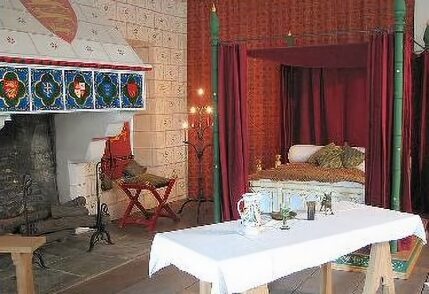
Further enlargements and improvements were carried out by King Edward I between 1275 and 1285, in whose reign the Tower began to take on it's present form. Edward vastly improved the Tower's defences by adding battlements and a stone causeway. Edward I was a seasoned castle builder, and used his experience of siege warfare during the crusades to bring innovations to castle building. His programme of castle building in Wales heralded the introduction of the widespread use of arrowslits in castle walls across Europe, drawing on Eastern influences.
At the Tower of London, Edward filled in the moat dug by Henry III and built a new curtain wall along its line, creating a new enclosure. A new moat was created in front of the new curtain wall. Further Towers were added, including the Byward and Beauchamp Towers. In an attempt to make the castle self-sufficient, Edward I also added two watermillsToday costumed guides paint a picture of life at the court of Edward I in the recently restored rooms of his Medieval palace.
That great son of Scotland, William Wallace, was housed in the Brick Tower by Edward I, before the ordering of his execution. Wallace suffered a slow and gruesome death, being hung, drawn and quartered at Smithfield, for his heroic defiance of King Edward in the cause of Scottish independence.
The Tower of London was the most important royal prison in England. However, throughout its long history, people have famously managed to escape. One such was Roger Mortimer, 1st Earl of March, who in 1322 was aided in his escape from the Tower by the Sub-Lieutenant of the Tower who let Mortimer's men inside. They hacked a hole in his cell wall and Mortimer escaped to a waiting boat, to flee to France and there join up with Edward II's queen, Isabella of France, from there they plotted and launched an invasion which was to lead to the abdication of the king in favour of his son, Edward III. Edward was later murdered in a bestial fashion in Berkeley Castle. The Beauchamp Tower was added to the Tower complex by Edward I, it replaced a twin-towered gatehouse on the site which had been built by his father, Henry III. The tower derives its name from Thomas Beauchamp, Earl of Warwick, who Richard II imprisoned there 1397 - 99.
There are some interesting inscriptions carved on the walls by past prisoners, the most famous of these is a memorial to the Dudley brothers, sons of John Dudley, Earl of Warwick, Lord Protector in the reign of Edward VI, whose son Guilford was the husband of the ill-fated Lady Jane Grey. Edward II's son, Edward III had his brother-in-law, David II, King of Scots imprisoned in the Tower after he had been wounded and captured at the Battle of Neville's Cross in 1346. Later in the reign, the Tower also played host to the King of France. King John and his son Phillip had been captured by Edward's eldest son, the famous Black Prince, at the Battle of Poitiers in 1356, where the latter covered himself in glory and became a national hero. It was the custom of the time for ransom to be demanded noble prisoners taken in battle, France had to raise three million Florences for King John's return.
WakefieldTower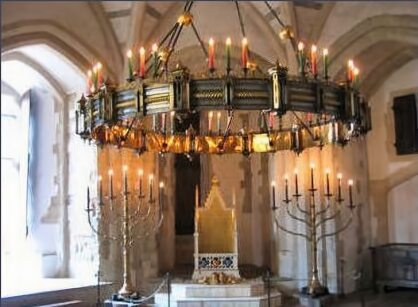
The Tower during the Wars of the Roses
The Wars of the Roses saw the incarceration of further royal and noble prisoners in the Tower. The unfortunate Lancastrian King, Henry VI himself was imprisoned in the Tower for many years by his distant cousin Edward IV, the first of the the Yorkist Kings who had usurped his throne.
Location of the murder of Henry VI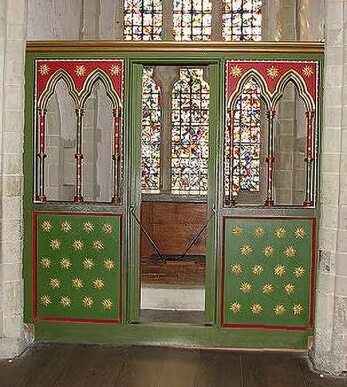
For much of his term of imprisonment Henry received humane treatment at the hands of his cousin Edward. However, after the death of Henry's son and heir, Edward, the Lancastrian Prince of Wales, at the Battle of Tewkesbury, his fate was sealed.
The decision was reached that to prevent further rebellion and bloodshed, the Lancastrian figurehead would have to be removed. Henry was murdered in the Tower on the night of 21st May 1471, while at prayer in the oratory of the Wakefield Tower.
Richard, Duke of Gloucester, the future Richard III, is named as a likely candidate for committing the foul deed by a contemporary chronicler, although ultimate responsibility for Henry's death must be placed at the feet of Edward IV himself. Despite Yorkist denials of any violence toward him, giving out that he had died from "pure melancholy and displeasure" an examination of Henry's skull, which took place in 1910, found it to be "much broken", the hair matted with blood on the skull confirmed him to have met a violent end.
A marble tablet placed in the Wakefield Tower in his memory marks the spot where Henry VI is traditionally said to have met his untimely end. Each year, on the eve of the anniversary of his death, the ceremony of the lilies and the roses are played out, white lilies for Eton College and white roses for King's College, Cambridge are placed there in memory of their founder.
Edward IV was later to imprison his troublesome and treacherous brother, George, Duke of Clarence, Shakespeare's "quicksand of deceit", in the Tower on a charge of treason. Clarence had previously rebelled against Edward and his recent threatening behaviour had tried his patience to the limit, compelling him to strike out against him. Their mother, Cecily Neville, Duchess of York, asked that her son's execution should not be a public spectacle. George was accordingly executed secretly in the Tower on 18th February 1478. He is reported to have suffered the grotesque death of being drowned in a butt of Malmsey wine. Edward was later to regret this action and it was known to have played on his conscience in later years.
The Princes in the Tower
One of the most long debated mysteries associated with the Tower of London is that of the tragic disappearance of the so-called Princes in the Tower within its walls. At his death, Edward IV left his brother Richard, Duke of Gloucester, as Lord Protector to his young son, the new king. In what is perhaps the most pathos evoking event ever encompassed within the walls of the fortress, Richard imprisoned his nephews Edward V and Richard, Duke of York there in 1483 and seized the throne for himself.
The two boys were reported to have been seen playing in the garden, but after Richard's coronation began to be seen less and less behind the bars and windows of the Tower, rumour was rife at the time that they had been done away with and they were never again seen alive.
The children were housed in what was then known as the Garden Tower, it obtained sinister connotations and was re-named the Bloody Tower only after the two boys disappearance and likely murder.
The Bloody Tower, where Edward V and his brother 'The Princes in the Tower' were imprisoned
The Bloody Tower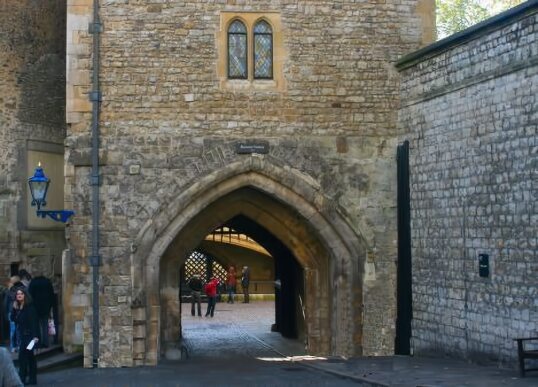
What is believed to be the remains of these two children were unearthed by workmen who were in the course of demolishing a staircase leading to the chapel in the White Tower nearly two hundred years later, in 1674. Although they have never been proved to be the bones of the two princes, King Charles II had them re-interred in the Henry VII chapel at Westminster Abbey, where they now lie close to their supposed sister, Elizabeth of York. The bones were subjected to an examination in 1933, which controversially concluded that they were the bones of the two princes. For a more in-depth examination of the case: Murder of the Princes in the Tower
The Bloody Tower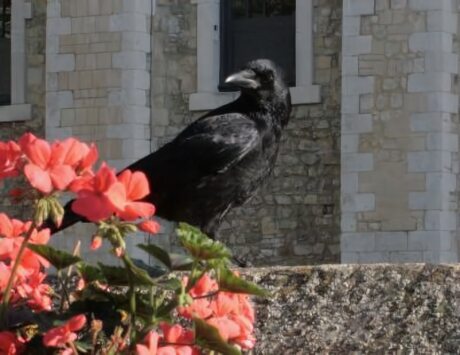
The Tower Ravens
One of the many legends that have grown around and cling to the Tower of London like the damp, grey London fog that lapped around its walls, is that of the Tower ravens. The legend, of unknown antiquity, states that if the ravens present at the Tower should leave, the Tower itself would fall, along with the entire kingdom.
Long before the conquest, ravens had been a familiar sight in the streets of London, where they were welcomed as natural scavengers who picked up bones and edible refuse from the gutters. The legend of the ravens, of unknown antiquity, has become of such importance that royal decrees have been issued protecting the birds for hundreds of years.
It was said to be King Charles II (1660-1685) who first insisted that the ravens of the Tower should be protected. The Tower's ravens cannot fly away because the flight feathers on one wing are kept clipped. With the single-wing clipped, they can only fly for short distances to perch.
It was Charles II, according to the stories, who first insisted that the ravens of the Tower should be protected. The decree requires that at least six birds be kept at the Tower at any given time. There is at present an official Yeoman Warder termed the Raven Master, who tends to the birds. The ravens are lodged by the Wakefield Tower. Each Tower raven has a different coloured band on one leg, to make it easier to identify individual birds. Ravens in captivity in the Tower grounds have reached the age of over 40 years
External links to other Historic BuildingsTintagel Castle, Cornwall, reputed birthplace of King Arthur
Beeston Castle Historic Beeston Castle in Cheshire.
